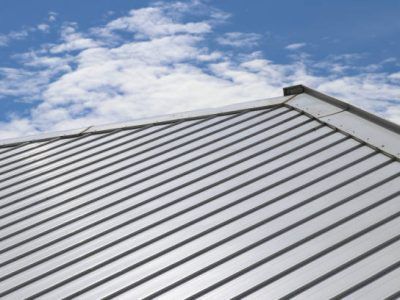
The Result of Saltwater Exposure on Florida Roofing Materials
The Corrosive Effects of Saltwater

The body content of your post goes here. To edit this text, click on it and delete this default text and start typing your own or paste yoFlorida boasts stunning coastal views and a vibrant seaside lifestyle. However, this proximity to saltwater environments presents unique challenges, particularly for homeowners' roofs. The corrosive effects of saltwater exposure can significantly impact the integrity and lifespan of roofing materials, necessitating careful consideration and proactive maintenance strategies. In this comprehensive guide, we'll delve into the various ways saltwater exposure affects roofing materials in Florida. From understanding the corrosive mechanisms to exploring preventive measures, homeowners can gain valuable insights into protecting their roofs against the harsh coastal environment.
Saltwater contains high concentrations of sodium chloride (NaCl), which is highly corrosive, especially in humid coastal climates like Florida. When saltwater comes into contact with roofing materials, it initiates chemical reactions that accelerate deterioration and corrosion.
1. Metal Roofing: Metal roofs, such as those made of steel or aluminum, are particularly susceptible to saltwater corrosion. Saltwater promotes the formation of rust, weakening the structural integrity of the roof and compromising its waterproofing properties.
2. Asphalt Shingles: While asphalt shingles are less prone to corrosion than metal, saltwater exposure can still degrade their protective coatings over time. This can lead to premature deterioration, causing shingles to become brittle and prone to cracking or curling.
3. Tile Roofing: Concrete or clay tiles are more resistant to saltwater corrosion compared to metal or asphalt. However, salt deposits can accumulate on the surface of tiles, leading to discoloration and erosion of the protective glaze.
4. Wood Shakes: Wooden shakes and shingles may absorb saltwater, causing swelling, warping, and decay over time. Additionally, saltwater exposure can promote mold and mildew growth, further compromising the structural integrity of the roof.
The Impact of Saltwater Spray and Airborne Salt Particles
In coastal areas, saltwater spray and airborne salt particles are carried by ocean breezes, penetrating deep into the surrounding environment. This salt-laden air can settle on rooftops, gradually corroding roofing materials even if direct contact with seawater is limited.
1. Saltwater Spray: During storms or high winds, saltwater spray can be carried inland, reaching properties located several miles from the coast. This spray can deposit salt particles on roofs, windows, and exterior surfaces, accelerating corrosion and deterioration.
2. Airborne Salt Particles: Even in the absence of storms, airborne salt particles are omnipresent in coastal environments. These particles settle on rooftops and penetrate roofing materials, leading to gradual corrosion and degradation over time.
The Importance of Proactive Maintenance and Protective Measures
Given the pervasive nature of saltwater exposure in coastal regions, proactive maintenance and protective measures are essential for preserving the integrity of roofing materials.
1. Regular Inspections: Schedule annual roof inspections with a qualified roofing contractor to assess the condition of your roof and identify any signs of saltwater damage or corrosion. Early detection allows for prompt repairs and preventive measures.
2. Cleaning and Decontamination: Regularly clean your roof to remove salt deposits, dirt, and debris. Use a mild detergent solution and a soft brush to gently scrub the surface, being careful not to damage roofing materials. Rinse thoroughly with clean water afterward.
3. Sealing and Coating: Consider applying protective sealants or coatings to your roof to create a barrier against saltwater intrusion. These coatings can help prevent corrosion and extend the lifespan of roofing materials, especially for metal roofs.
4. Rust Inhibitors: For metal roofs, rust inhibitors can be applied to prevent the formation of corrosion and protect against saltwater exposure. These inhibitors create a protective barrier that inhibits the chemical reactions responsible for rust formation.
5. Choosing Resilient Materials: When installing or replacing your roof, opt for roofing materials that are specifically designed to withstand saltwater exposure. Look for corrosion-resistant options such as stainless steel, aluminum, or coated metal roofing products.
What Are The Signs of Saltwater Damage On A Roof?
Identifying signs of saltwater damage on a roof is essential for addressing issues promptly and preventing further deterioration. Here are common signs to watch for:
1. Rust Formation: For metal roofing materials such as steel or aluminum, rust formation is a clear indication of saltwater damage. Rust typically appears as reddish-brown discoloration on metal surfaces, often starting at seams, fasteners, or edges where saltwater can accumulate.
2. Discoloration: Saltwater exposure can cause discoloration on various types of roofing materials. This may manifest as faded or stained areas on shingles, tiles, or metal surfaces. Discoloration is often accompanied by a dull, weathered appearance, indicating degradation of protective coatings.
3. Corrosion of Fasteners: Saltwater can corrode metal fasteners used to secure roofing materials in place. Signs of corrosion may include rusted or deteriorated nails, screws, or bolts, particularly in areas exposed to saltwater spray or airborne salt particles.
4. Efflorescence: Efflorescence is the white powdery residue that forms on the surface of masonry or concrete materials when salt deposits are drawn to the surface by moisture. On roofs, efflorescence may indicate saltwater infiltration and subsequent evaporation, leaving behind salt residue.
5. Brittleness and Cracking: Asphalt shingles and other roofing materials may become brittle and prone to cracking or splitting when exposed to saltwater over time. This can compromise the integrity of the roof and lead to leaks or water intrusion.
6. Accelerated Wear and Tear: Saltwater damage can accelerate the overall wear and tear of roofing materials, causing them to deteriorate more rapidly than expected. This may include premature aging, degradation of protective coatings, and loss of structural integrity.
By recognizing these signs of saltwater damage on your roof, you can take proactive measures to address issues promptly and protect the integrity of your home's roofing system. Regular inspections and maintenance are key to identifying and mitigating saltwater-related damage before it leads to more significant issues.
By understanding the mechanisms of saltwater corrosion, scheduling regular inspections, implementing cleaning and protective coatings, and choosing resilient materials, homeowners can safeguard their roofs against the harsh coastal environment. Ultimately, investing in preventive maintenance and protective measures is key to ensuring the long-term durability and performance of roofing systems in saltwater-prone regions like Florida.ur own from a different source.
Contact Info:
1014 W Dixie Ave, Leesburg FL 34748
1014 W Dixie Ave, Leesburg FL 34748
Open Hours:
Mon–Fri: 8 am – 5 pm
Saturday: By Appointment
Sunday: Closed
Navigation
All Rights Reserved Nieves & Baker Roofing, LLC| Website Managed by Leads By Vinny

